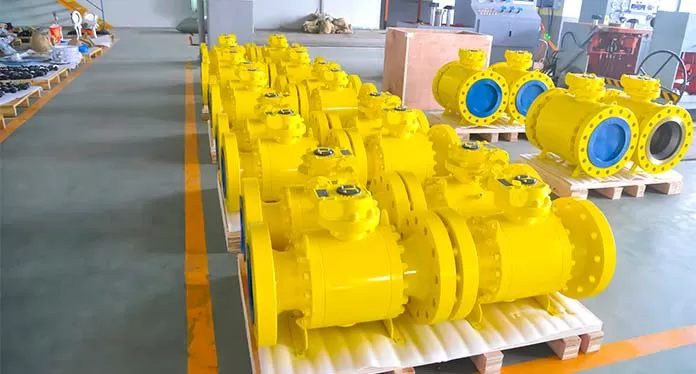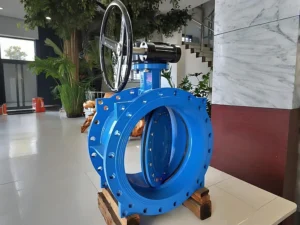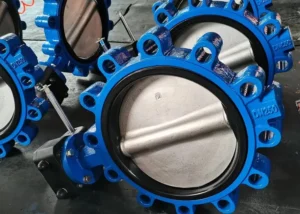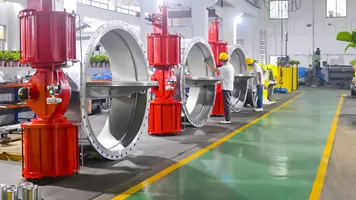Introduction: Technical Challenges of High-Pressure Oil & Gas Pipeline Valves
In the global oil and gas industry, high-pressure pipeline systems impose strict requirements on valve sealing reliability, structural strength, and long-term weather resistance. As core control equipment complying with the American Petroleum Institute standard, API 6D trunnion mounted ball valves address torque surge and sealing failure issues of traditional ball valves under high-pressure conditions through their trunnion support structure and double block and bleed (DBB) design. This article analyzes technical standards, structural design, manufacturing processes, and practical application scenarios to provide selection (selection) references for oil and gas pipeline projects.

I. API 6D Standards and Technical Positioning of Trunnion Mounted Ball Valves
1.1 Core Requirements of API 6D Standards
API 6D (American Petroleum Institute Specification 6D) is specially formulated for oil and gas pipeline valves, covering the entire process of design, manufacturing, and testing:
- Pressure Classes: Class 150~Class 2500 (PN16~PN420), suitable for 1.6MPa~42MPa working conditions
- Temperature Range: -46℃~400℃, supporting LNG cryogenic transportation to high-temperature steam scenarios
- Seal Testing: Requires bi-directional zero leakage (API 598 Class VI), with shell strength test pressure at 1.5 times the rated pressure
- Material Certification: Valve bodies must pass NACE MR0175 certification (sulfide stress corrosion resistance)
1.2 Technical Comparison Between Trunnion Mounted and Floating Ball Valves
| Technical Dimension | Trunnion Mounted Ball Valve | Floating Ball Valve |
|---|---|---|
| Structural Feature | Ball supported by upper and lower trunnions, stem only transmits torque | Ball floats, stem bears medium thrust |
| High-Pressure Adaptability | Low torque (30%~50% lower than floating type), suitable for Class 600+ conditions | Insufficient sealing specific pressure under high pressure, prone to leakage |
| Sealing Reliability | Double seat sealing with backpressure self-compensation | Single seat sealing, dependent on medium pressure pushing |
| Applicable Bore | DN50~DN1200 (2″~48″) | DN15~DN300 (0.5″~12″) |
II. Core Structure and Working Principle of Trunnion Mounted Ball Valves
2.1 Trunnion Support System Design
Trunnions are made of forged alloy steel (e.g., A182 F11) with nitrided surfaces (hardness HV≥900), supported in two ways:
- Upper Trunnion Support: Suitable for DN≤300, compact structure;
- Lower Trunnion Support: Adopted for DN>300 to avoid ball sagging due to self-weight, ensuring uniform pressure on sealing surfaces.
2.2 Double Block and Bleed (DBB) Structure
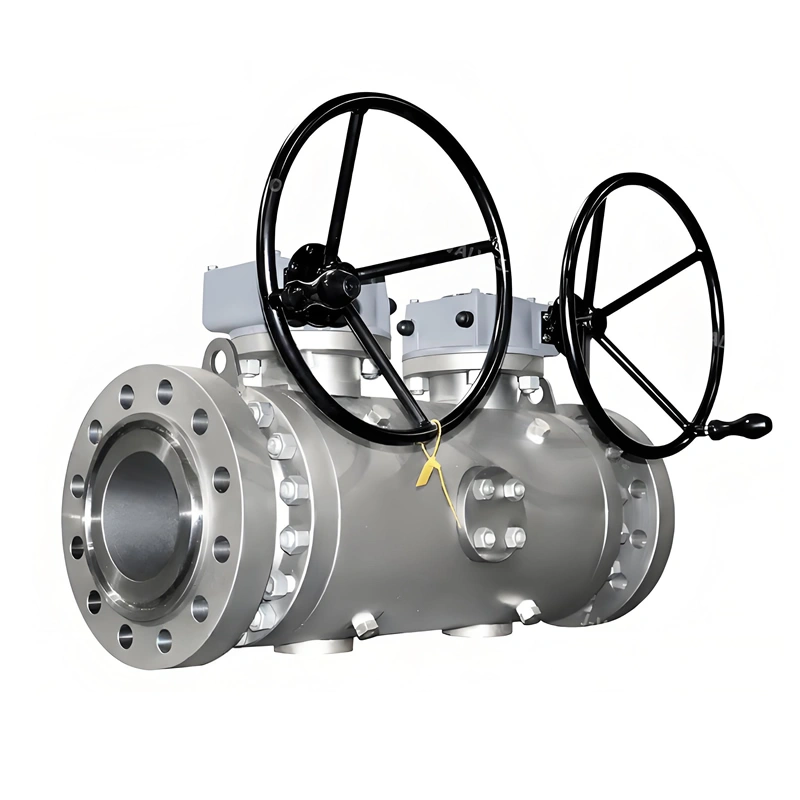
The valve features bi-directional sealing capability, and the valve cavity can release abnormal pressure through a relief valve:
- Forward Sealing: Medium pressure pushes the downstream seat against the ball to form the main seal;
- Reverse Sealing: The upstream seat is equipped with a spring-loaded mechanism to provide initial sealing specific pressure without medium pressure;
- Cavity Pressure Relief: When cavity pressure exceeds the limit due to temperature rise, the relief valve opens automatically (set at 1.3 times the rated pressure).
2.3 Fire and Electrostatic Protection Design
- Fire Protection Structure: Seats use metal backup seals (e.g., Inconel 718), which can still block media after primary seals fail during fires;
- Anti-Static Device: Conductive springs are set between the ball, stem, and body to ensure electrostatic grounding resistance ≤10Ω, preventing sparks from igniting media.
III. Key Technical Parameters and Material Configurations
3.1 Pressure-Temperature Rating Table (Typical Values)
| Pressure Class | Rated Pressure at Ambient Temperature (MPa) | Rated Pressure at -46℃ (MPa) | Rated Pressure at 400℃ (MPa) |
|---|---|---|---|
| Class 300 | 5.0 | 4.2 | 3.8 |
| Class 600 | 11.0 | 9.5 | 8.2 |
| Class 900 | 15.0 | 13.0 | 11.5 |
3.2 Material Combination Schemes (Categorized by Medium Characteristics)
| Medium Type | Valve Body Material | Ball Material | Seat Sealing Surface | Applicable Standard |
|---|---|---|---|---|
| Crude Oil/Natural Gas | A216 WCB (cast steel) | A182 F6a (stainless steel) | PTFE+Inconel 625 | API 6D |
| H₂S-Containing Acidic Medium | A352 LCC (low-temperature steel) | A182 F316L | Metal hard seal (Stellite) | NACE MR0175 |
| LNG Cryogenic Medium | A352 LCB (-46℃) | A182 F304L | Cryogenic PTFE+nickel-based alloy | BS 6364 (LNG standard) |
| High-Temperature Steam | A217 WC9 (cast steel) | A182 F91 | Metal overlay (Stellite) | ASME B16.34 |
3.3 Performance Test Indicators
- Seal Leakage Rate: ≤5×10⁻⁶ std cm³/s for gas media (API 598 Class VI), ≤0.01 drops/minute for liquid media;
- Operating Torque Stability: Torque fluctuation ≤15% after 10,000 cycles;
- Fatigue Life: Completes 5,000 switch cycles without failure at 1.1 times the rated pressure.
IV. Manufacturing Processes and Quality Control Systems
4.1 Valve Body Forging Processes
- Open Die Forging vs. Closed Die Forging:
- DN≤200 uses closed die forging (forging accuracy ±0.5mm) with uniform streamline distribution;
- DN>200 uses open die forging (forging allowance 3~5mm), detected for internal defects by ultrasonic testing (UT).
- Heat Treatment Process:
- Austenitization (860℃×2h) → 2. Oil quenching (cooling rate ≥50℃/min) → 3. Tempering (680℃×4h), ensuring valve body tensile strength ≥550MPa, elongation ≥22%.
4.2 Precision Machining of Ball
- 5-Axis CNC Machining: Ball roundness ≤0.02mm, surface roughness Ra≤0.8μm;
- Sealing Surface Grinding: Diamond wheel grinding, flatness ≤0.005mm (equivalent to the thickness of 3 A4 papers);
- Surface Hardening Treatment: HVOF sprayed WC-Co coating, thickness 500μm, hardness HV≥1200, abrasion resistance life increased by 5 times.
4.3 Full-Process Quality Control
| Process | Detection Method | Standard Requirements |
|---|---|---|
| Material Incoming | Optical Emission Spectroscopy (OES) | Composition deviation ≤0.5% (e.g., C ±0.02%) |
| Forged Blanks | Ultrasonic Testing (UT) | No defects ≥2mm equivalent |
| Machining | Coordinate Measuring Machine (CMM) | Dimensional tolerance ±0.05mm |
| Welding | Radiographic Testing (RT) | ASME BPVC Section VIII Div. 1 |
| Finished Product Testing | Hydrostatic/Pneumatic Testing | API 598 standard, pressure holding ≥15 minutes |
V. Typical Application Scenarios in High-Pressure Oil & Gas Pipelines
5.1 Onshore Long-Distance Pipeline Trunk Control
- Working Conditions: Class 900 (15MPa), medium is sour natural gas (H₂S≤300ppm), temperature 60℃;
- Valve Configuration: DN600 trunnion mounted ball valve, valve body using A352 LCC+Stellite 6 inner wall surfacing, seat with metal hard seal+graphite auxiliary seal;
- Technical Advantages:
- Bi-directional sealing prevents medium backflow during pigging, DBB structure ensures maintenance safety;
- Anti-static design avoids electrostatic sparks from natural gas friction;
- Remote electric actuator (explosion proof grade Ex d IIB T4) enables SCADA system centralized control.
5.2 Offshore Platform Wellhead Equipment
- Working Conditions: Class 1500 (25MPa), medium is crude oil+hydrate, temperature -20℃~120℃;
- Special Design:
- Valve body uses duplex steel (2205) for chloride corrosion resistance (Cl⁻≤5,000ppm);
- Trunnion bearings use PTFE+bronze composite material for seawater corrosion resistance;
- Actuator is equipped with a hydraulic accumulator for emergency shutdown (ESD) in case of platform power failure.
5.3 LNG Receiving Station Cryogenic Pipelines
- Working Conditions: Class 600 (11MPa), medium is liquefied natural gas (-162℃);
- Key Technologies:
- Valve body uses A352 LCB low-temperature steel, impact energy ≥34J at -196℃;
- Seat seal adopts multi-layer PTFE+nickel mesh composite structure, cold shrinkage compensation ±0.3mm;
- Extended stem (200mm extension) prevents external heat conduction to the sealing surface.
5.4 Refinery High-Pressure Hydrogenation Units
- Working Conditions: Class 2500 (42MPa), medium is hydrogen+naphtha, temperature 350℃;
- Safety Design:
- Fireproof structure passes API 607 5th edition test, sealing failure time ≥30 minutes during fire;
- Cavity relief valve set at 54.6MPa (1.3×rated pressure) to prevent overpressure rupture;
- Metal shielding layer between ball and seat avoids sealing surface cracking caused by hydrogen embrittlement.
VI. Core Product Advantages and Industry Comparison
6.1 Performance Comparison with Gate Valves
| Index | Trunnion Mounted Ball Valve | Parallel Double Disc Gate Valve |
|---|---|---|
| Flow Resistance Coefficient | 0.15 (full bore) | 0.8 (with flow guide hole) |
| Sealing Reliability | Bi-directional zero leakage | Unidirectional sealing prone to failure |
| Maintenance Cycle | 8~10 years (normal conditions) | 3~5 years |
| Switching Time | 15s (DN600 electric) | 60s |
6.2 Life Cycle Cost (LCC) Advantages
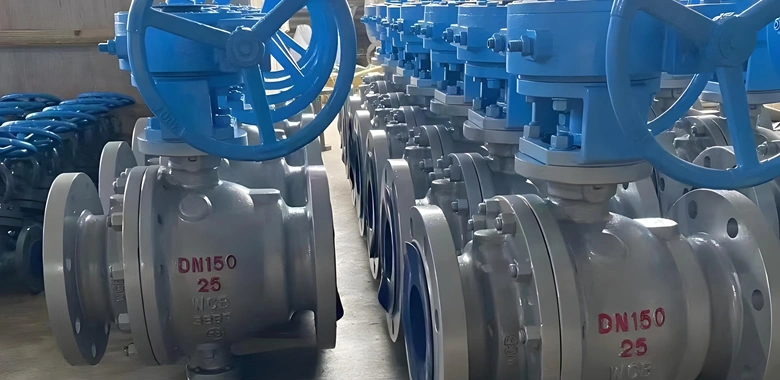 Taking a DN300 Class 600 valve as an example (20-year service life):
Taking a DN300 Class 600 valve as an example (20-year service life):
- Procurement Cost: 20%~30% higher than gate valves, but 15% lower than plug valves;
- Maintenance Cost: Cumulative lubrication+seal replacement costs $8,500 less than gate valves;
- Downtime Loss: Low leakage rate reduces unplanned downtime by 70%, saving $12,000;
- Total LCC: 35% lower than gate valves and 22% lower than plug valves.
6.3 Technical Innovations
- Intelligent Monitoring Integration: Built-in pressure sensor (accuracy ±0.5%FS) and temperature sensor (accuracy ±1℃) for real-time cavity status transmission;
- Lubrication System Optimization: Pulsed grease injection valve reduces grease consumption by 40%, avoiding sealing surface damage from excessive greasing;
- Lightweight Design: Valve body structure optimized via finite element analysis (FEA), DN600 valve weight 18% lighter than traditional designs.
VII. Selection Guide and Supplier Evaluation
7.1 Key Selection Parameters Table
| Evaluation Dimension | Selection Basis | Recommended Standard Values |
|---|---|---|
| Media Characteristics | Sulfur content, particle size, water content | H₂S≤1,000ppm, particles≤50μm |
| Operating Conditions | Maximum working pressure/temperature, switching frequency | Pressure fluctuation ≤10%, switching ≥1 time/day |
| Installation Environment | Onshore/offshore, seismic intensity, corrosion protection grade | Offshore platforms should meet NORSOK standards |
| Control Requirements | Manual/electric/hydraulic, ESD response time | ESD response ≤500ms |
7.2 Supplier Technical Capability Evaluation
-
Design Capability:
- Whether capable of 3D modeling and computational fluid dynamics (CFD) analysis for API 6D valves;
- Whether there are design cases for high-pressure valves (Class 2500).
-
Manufacturing Qualifications:
- Whether self-owned forging hammer (≥10,000 tons) for valve body forging;
- Whether API 6D Monogram certified (certificate number traceable).
-
Testing Facilities:
- Hydrostatic test bench maximum pressure ≥70MPa, volume ≥500L;
- Cryogenic test chamber temperature ≤-196℃, capable of simulating LNG conditions.
-
After-Sales Service:
- Whether on-site emergency maintenance can be provided (arrival within 48 hours);
- Whether valve health management system (VHM) remote monitoring service is available.
VIII. Industry Application Cases and Market Trends
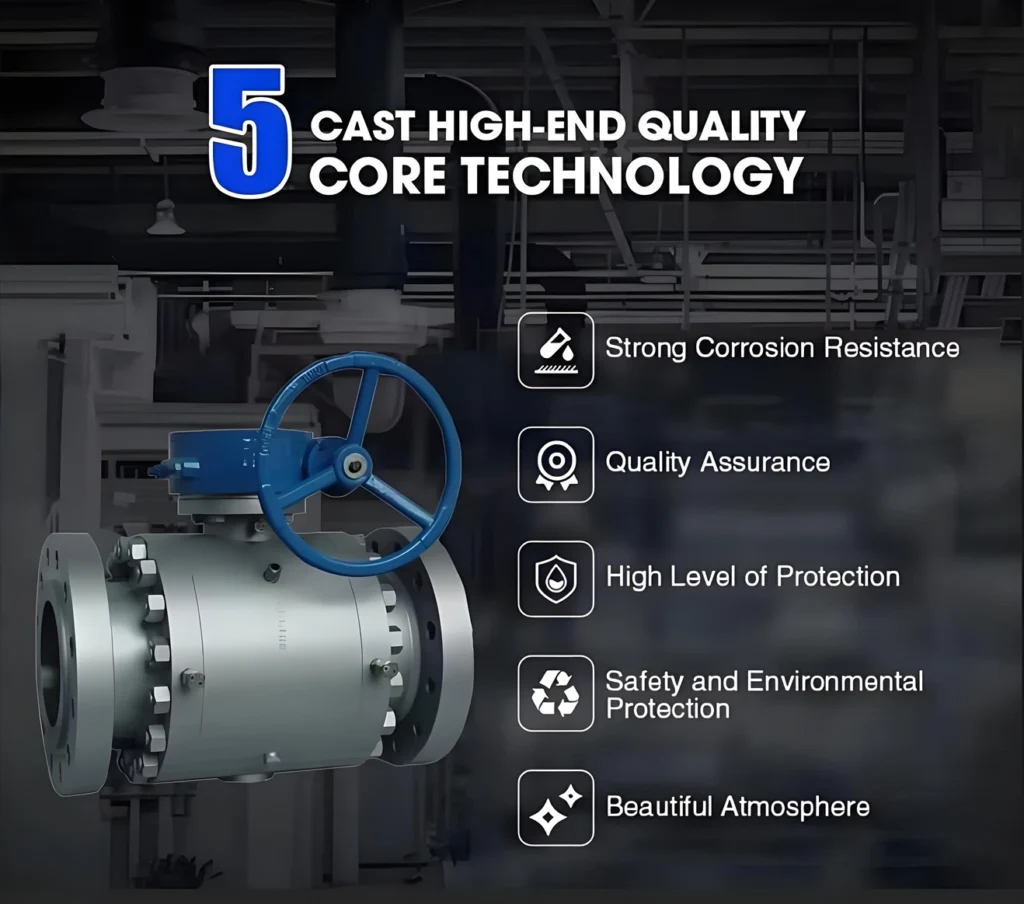
8.1 800km Natural Gas Pipeline Project in the Middle East
- Project Requirements: Transporting natural gas with H₂S (500ppm), pressure 10MPa, temperature 50℃;
- Valve Configuration: 56 sets of DN700 Class 600 trunnion mounted ball valves, valve body using A352 LCC+316L stainless steel lining;
- Operation Effect: 3 years of leak-free operation, pressure difference across the valve during pigging ≤0.05MPa, far lower than 0.3MPa of gate valves.
8.2 Arctic LNG 2 Project
- Technical Challenges: Preventing valve frosting and seal shrinkage at -162℃;
- Solutions:
- Long-neck design for valve stem (300mm extension), filled with cryogenic thermal insulation materials;
- Valve seat springs use Inconel 718, cold-state spring force loss ≤5%;
- Acceptance Standard: 100 switch cycles at -196℃ with leakage rate Always ≤1×10⁻⁹m³/s.
8.3 Market Trend Analysis
- Intelligence: 85% of new orders require valves to integrate IoT modules for remote diagnosis;
- Green Manufacturing: CE certification in the EU adds carbon footprint requirements, forging process energy consumption ≤3.2kWh/kg;
- Material Innovation: Metal matrix composite (MMC) seats begin trial use, wear resistance life 8 times higher than traditional materials.
API 6D trunnion mounted ball valves demonstrate excellent sealing reliability and long-life advantages in harsh conditions such as high pressure, low temperature, and sulfur content through structural innovation and material optimization. For B2B procurement decisions, it is recommended to focus on suppliers’ full-process manufacturing capabilities, third-party certification qualifications, and actual project cases, and select the optimal technical solution based on medium characteristics and operating conditions to achieve safe and efficient operation of oil and gas pipeline systems.


